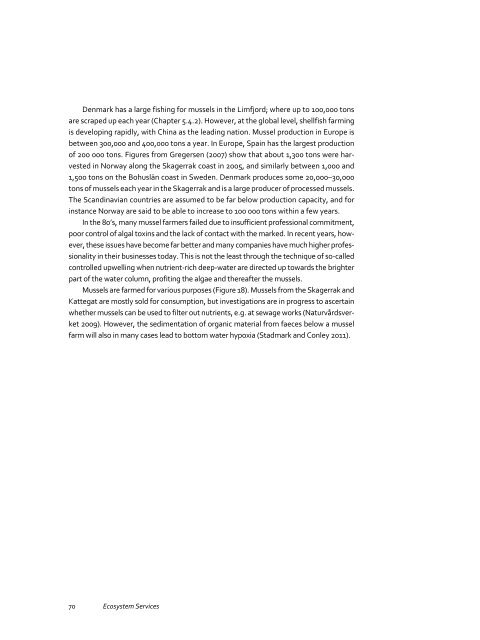Ecosystem Services
FULLTEXT01
FULLTEXT01
You also want an ePaper? Increase the reach of your titles
YUMPU automatically turns print PDFs into web optimized ePapers that Google loves.
Denmark has a large fishing for mussels in the Limfjord; where up to 100,000 tons<br />
are scraped up each year (Chapter 5.4.2). However, at the global level, shellfish farming<br />
is developing rapidly, with China as the leading nation. Mussel production in Europe is<br />
between 300,000 and 400,000 tons a year. In Europe, Spain has the largest production<br />
of 200 000 tons. Figures from Gregersen (2007) show that about 1,300 tons were harvested<br />
in Norway along the Skagerrak coast in 2005, and similarly between 1,000 and<br />
1,500 tons on the Bohuslän coast in Sweden. Denmark produces some 20,000–30,000<br />
tons of mussels each year in the Skagerrak and is a large producer of processed mussels.<br />
The Scandinavian countries are assumed to be far below production capacity, and for<br />
instance Norway are said to be able to increase to 100 000 tons within a few years.<br />
In the 80’s, many mussel farmers failed due to insufficient professional commitment,<br />
poor control of algal toxins and the lack of contact with the marked. In recent years, however,<br />
these issues have become far better and many companies have much higher professionality<br />
in their businesses today. This is not the least through the technique of so-called<br />
controlled upwelling when nutrient-rich deep-water are directed up towards the brighter<br />
part of the water column, profiting the algae and thereafter the mussels.<br />
Mussels are farmed for various purposes (Figure 18). Mussels from the Skagerrak and<br />
Kattegat are mostly sold for consumption, but investigations are in progress to ascertain<br />
whether mussels can be used to filter out nutrients, e.g. at sewage works (Naturvårdsverket<br />
2009). However, the sedimentation of organic material from faeces below a mussel<br />
farm will also in many cases lead to bottom water hypoxia (Stadmark and Conley 2011).<br />
70 <strong>Ecosystem</strong> <strong>Services</strong>


